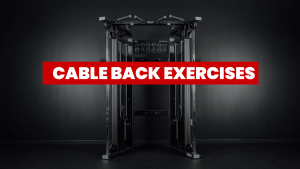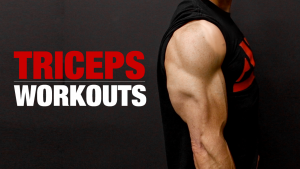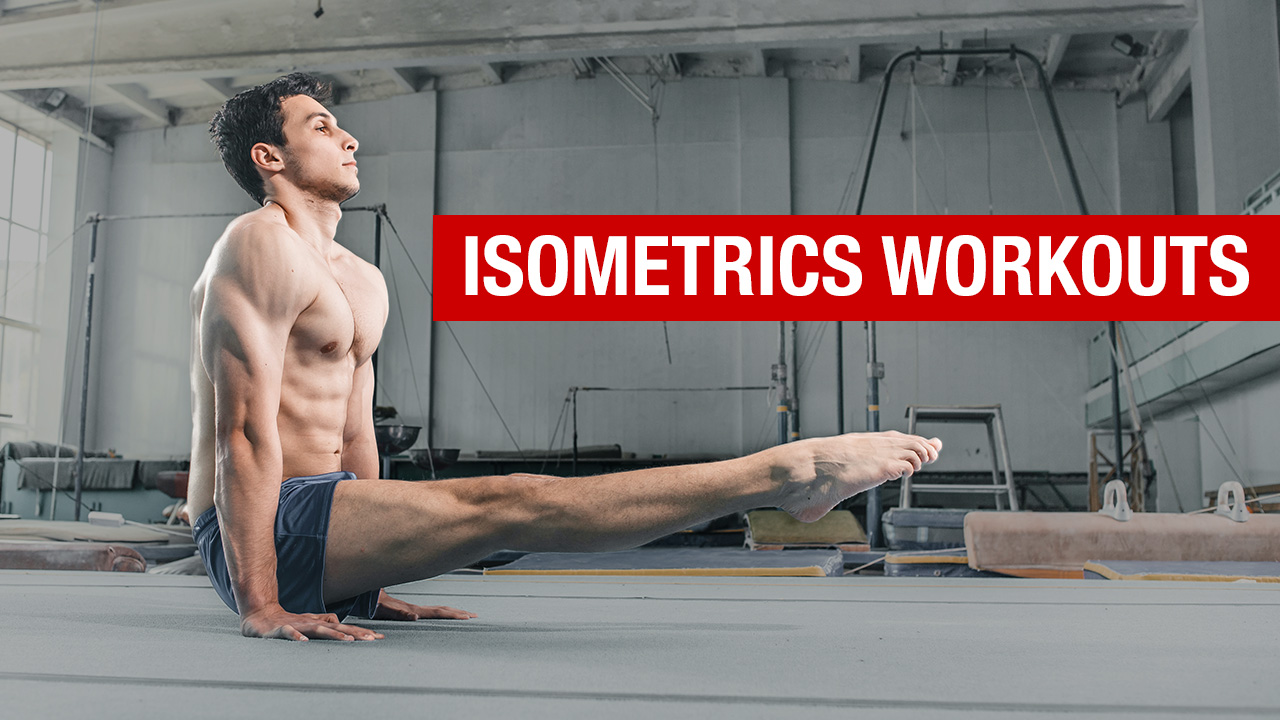
THE BENEFITS OF ISOMETRICS
Should you be doing isometric training?
This question comes up more than you’d think, especially for those focused on building muscle and strength.
A lot of people will tell you straight up: Isometrics are a waste of time.
They argue that isometric exercises don’t build muscle and, since they don’t leave you sore the next day, they’re not worth including in your workout routine.
But here’s the thing:
Just because isometrics don’t leave you limping for days after doesn’t mean they can’t help you grow muscle.
The reason you don’t feel sore is that isometric exercises don’t involve the eccentric contractions that cause muscle damage and the delayed onset muscle soreness (DOMS) that comes with traditional workouts.
However, soreness isn’t the only indicator of muscle growth.
Isometric holds can absolutely increase muscle mass and improve strength for two very big reasons that often get overlooked.
If you’re looking to boost muscle strength, enhance core stability, and get all the benefits without the increased risk of joint pain, it’s time to take a serious look at isometric training.
HOW ISOMETRICS BUILD MUSCLE
When it comes to muscle growth and strength, isometric exercises are often overlooked in favor of dynamic movements.
But the truth is, just because you’re not feeling next-day muscle fatigue doesn’t mean you can’t adopt an isometric workout routine.
Isometric exercises can play a critical role in building muscle mass and strength over time by engaging your muscles in ways traditional exercises can’t.
Let’s break down why isometric training should be in your fitness routine and how it can help you reach your muscle-building goals.
TYPES OF ISOMETRIC TRAINING: YIELDING VS. OVERCOMING
To understand how isometric exercises work, it’s essential to recognize the two primary forms: yielding and overcoming isometrics.
YIELDING ISOMETRICS
This type of exercise involves holding a position to resist movement.
For example, if you hold a plank or squat position, your muscles are working to prevent movement while maintaining a static position.
In a Lateral Raise, this would be holding the dumbbells at shoulder height and resisting the pull of gravity.
These static positions generate tension, which is key for muscle activation and growth.
OVERCOMING ISOMETRICS
In this variation, you’re applying maximum effort against an immovable object.
Imagine pushing against a barbell locked into place or performing an isometric curl against a weight you can’t move.
The goal here is to engage as many muscle fibers as possible, resulting in a significant boost in muscle engagement and tension.
INTENSITY OF TENSION
The first reason isometric action can build muscle lies in the intensity of the tension.
Tension is crucial for muscle hypertrophy, and isometric contractions allow you to generate more sustained tension than traditional exercises.
Here’s why:
In a typical concentric contraction—like a Bicep Curl—your muscles experience fluctuations in tension.
As you lift the weight, your muscles decelerate at the top, reducing the tension.
However, during isometric holds, you’re maintaining peak tension throughout the entire period of time.
Because of this continuous tension, more muscle fibers are recruited, which promotes muscle growth and strength gains.
This makes isometric movements, such as Planks or Isometric Squats, particularly effective for increasing muscle activation without the need for heavy weights or dynamic movement.
TIME UNDER TENSION
The second reason isometric action exercises work is the extended time under tension.
When you hold an isometric position for 30, 45, or even 60 seconds, you’re forcing your muscles to stay engaged without rest.
This constant strain challenges your muscle tissue and muscle fibers, leading to increased muscle mass and muscle strength over time.
For instance, holding a squat position or 20-second planks continuously recruits leg muscles and core muscles, while providing benefits similar to dynamic exercises, but with less joint movement.
This type of muscle engagement is especially useful for developing muscle endurance and stability, making it a great addition to any exercise routine.
Longer isometric holds—such as 45-second heavy isometric holds with a pair of 20-pound dumbbells in Isometric Bicep Curls—can fatigue your muscles in ways dynamic exercises can’t.
Whether you’re focusing on bodyweight exercises or using external measurement plates or dumbbells, the sustained pressure forces the muscle fibers to adapt, which leads to increased muscle activation levels and growth over time.
WHY ISOMETRICS DESERVE A PLACE IN YOUR FITNESS ROUTINE
Isometric exercises often get overlooked because they don’t involve the traditional dynamic movement you see in exercises like Squats or Biceps Curls.
But here’s the deal:
If you’re serious about hitting your fitness goals, whether it’s building muscle, improving athletic performance, or reducing injury risk, isometrics deserve a permanent spot in your workout routine.
These exercises are a proven way to maximize muscle activation and strength without adding stress to your joints or relying on heavy loads.
LOW-IMPACT, HIGH-REWARD
One of the biggest benefits of isometric training is that it involves low-impact exercises.
That means you can get serious muscle engagement without placing unnecessary strain on your knees, shoulders, or other joints.
If you’ve ever dealt with chronic knee pain or experienced joint discomfort during high-intensity workouts, isometrics offer a solution.
Exercises like Isometric Squat Holds or Planks allow you to maintain a static position that works your muscles without causing undue stress on your knee joints or compromising joint position.
Even with an external load, like holding a barbell overhead or performing Isometric Bicep Curls, your joints stay in a stable position, making isometric holds the go-to choice for improving muscle strength while keeping your joints safe.
Physical therapists often prescribe these exercises to people recovering from injury because they help build strength without the risk of aggravating injuries.
MAXIMIZED MUSCLE ACTIVATION
During an isometric hold, your muscles are forced to stay engaged without any joint movement.
This means your limb muscles, core muscles, and even oblique muscles are firing continuously to maintain the position.
Take the Classic Plank as an example—it might seem simple, but holding this position forces your core muscles, shoulders, and lower back to work together to keep your body position stable.
This sustained muscle activation at a specific joint angle allows for a deeper level of engagement than some traditional concentric muscle actions.
More time spent under tension leads to better muscle growth and strength gains, especially when combined with dynamic exercises like squats or curls.
By maintaining an isometric 30-second hold (minimum), you’re giving your muscles a serious workout, improving both muscle strength and muscle mass over time.
CONTROL BLOOD PRESSURE, ELEVATE PERFORMANCE
Another key benefit of isometric exercises is that they can help improve blood flow and blood pressure management.
When you hold a static position, like Isometric Squats or 20-second Planks, your muscles contract without movement, which temporarily restricts blood flow.
Over time, this type of contraction can help your blood vessels adapt, which is great for managing blood pressure.
However, it’s important to monitor your intensity.
Holding a position for too long or using a heavy load (like a 5 to 10-pound plate heavier than what you’re used to) can cause blood pressure elevations, especially if you’re new to isometric training.
This is where smart programming comes into play—start with lighter loads or bodyweight exercises and gradually increase your hold times and external load.
VERSATILITY FOR ALL FITNESS LEVELS
Isometric training is incredibly versatile, making it a great addition to your routine whether you’re an elite athlete or you’re just getting started.
Beginners can start with bodyweight isometric holds like Wall Sits or basic Shoulder Bridge exercises.
Meanwhile, advanced athletes can integrate heavier loads, such as a Bench Press set-up with barbell or performing Isometric Calf Raises with added weight.
By adjusting the load, repetition duration, or joint angle, you can scale isometrics to fit your current fitness level while still seeing major improvements in muscle activation and dynamic performance.
Even with limited equipment—a pair of dumbbells or a 5 to 10-pound plate—you can incorporate isometrics into your routine to get the benefits without needing to load up a barbell with a 100-110% 1RM load.
BOOST STRENGTH AND PERFORMANCE WITHOUT RISK OF INJURY
Isometric exercises not only help with building strength but can also enhance athletic performance by increasing your muscles’ ability to sustain high levels of tension.
Incorporating isometric holds into your isometric workout routine improves the adaptation relationship between muscle strength and endurance, which translates to better performance during dynamic movements like Calf Raises, Biceps Curls, or Squats.
Because you’re not constantly moving or changing directions, there’s less risk of injury during isometric exercises.
This makes them an excellent option for off-season training or recovery phases when you’re looking to maintain muscle strength and avoid joint strain.
HOW TO INCORPORATE ISOMETRIC TRAINING INTO YOUR ROUTINE
So, you want to level up your training? Well, you need to start incorporating isometrics into your workouts.
No, it’s not about just hanging out in a static position—it’s about taking control, creating tension, and making those muscles scream in the best way possible.
Let’s talk about how to add isometric training effectively into your routine to get the most out of every rep and every second of effort.
PAUSE STRATEGICALLY DURING REPS
Isometric training doesn’t have to be its own separate exercise—you can integrate it seamlessly into your existing movements.
One simple technique is to add a five-second pause at the bottom of each rep in your Push-Ups, Squats, or Biceps Curls.
By holding at the hardest point of the movement, you’re maximizing the tension and activating more muscle fibers.
Remember, it’s not about doing more reps; it’s about making each rep count.
This additional holding brings more intensity to your repetition maximum by engaging the muscle under tension for longer, increasing muscle fatigue and growth.
USE ISOMETRICS TO PRE-EXHAUST THE MUSCLES
Another killer way to use isometrics is as a pre-exhaust technique before performing your usual set of dynamic reps.
For example, hold a Plank for 30 seconds before you start doing mountain climbers, or hold at the bottom of a Squat for 10 seconds before cranking out Regular Squats.
This not only pre-fatigues the muscles, forcing them to work harder during the dynamic movement, but also helps improve the response relationship between strength and endurance.
This combo delivers better exercise values, taking your training up a notch without adding unnecessary volume.
ISOMETRIC HOLDS FOR TIME UNDER TENSION
To build muscle effectively, it’s all about time under tension. With isometrics, you want to aim for longer hold times—anywhere from 20 to 60 seconds.
The key here is to keep your body into position, with good form throughout the entire hold.
If you’re holding a lunge, keep your feet flat on the ground, your front knee at a 90-degree angle, and your back straight.
Maintaining tension for an extended period without letting your form break is where you get the maximum benefit.
This prolonged contraction keeps your muscles engaged longer, leading to better gains in muscle hypertrophy and endurance.
MID-RANGE HOLDS FOR ADDED STRENGTH GAINS
One of the often-overlooked techniques in exercise & fitness is holding at the mid-range of a movement—like pausing halfway through a biceps curl or holding at the midpoint of a shoulder raise.
These positions are often where you’re at your weakest and holding them forces your muscles to adapt by building strength in that specific range of motion.
This approach can enhance the benefit of percent effort during your workouts, meaning you get more out of each repetition by optimizing where you put in the most work.
END-OF-SET ISOMETRIC HOLDS
Another way to incorporate isometric training is to add a hold at the end of your set. After completing your reps, finish with a 15-30 second hold.
For example, after a set of Squats, hold the bottom position for as long as you can—keeping your chest up, feet flat, and core tight.
This additional holding taxes the muscles just when they’re at their most fatigued, helping you push beyond your typical limits and forcing adaptation.
This can significantly enhance muscle endurance and improve repetition maximum strength over time.
USE ISOMETRICS DURING COMPOUND EXERCISES
Compound exercises like Deadlifts, Bench Presses, and Rows are perfect for integrating isometric holds.
For instance, you can hold the barbell just off the ground for five seconds at the beginning of a Deadlift or hold the barbell midway during a Bench Press.
These types of holds help to reinforce stability and control, leading to a stronger overall lift.
Integrating these isometric holds during compound lifts helps improve stability, joint strength, and can boost your confidence in those heavy lifts.
FOCUS ON FORM OVER FUNCTION
When incorporating isometric training, it’s all about keeping your body into position. Whether you’re holding a squat or a push-up, make sure your form is on point.
Keeping your feet flat, engaging your core, and maintaining proper alignment ensures you’re getting the most out of each hold.
If you’re sacrificing form, you’re not maximizing the exercise intervention, and you’re putting yourself at risk of injury.
Proper form during isometric training also helps reinforce movement patterns, which translates into better performance in dynamic exercises.
THE BEST ISOMETRIC TRAINING EXERCISES
Now, don’t tell me you’re not training with your own body weight. I don’t care if you’re a huge iron addict—bodyweight training has a place in your routine.
Why? Because nothing replicates having total command over your body and how it moves through space.
And body weight exercises are one of the best ways to tap into the benefits of isometrics training.
This makes them a great place to start with learning how to do isometrics exercises.
Where and how you incorporate isometrics into your bodyweight training can make all the difference, especially when combined with dynamic movements.
I’m going to present my favorite isometric exercises, but keep in mind, you can take the same principles and simply apply them to your own favorite exercises.
ISOMETRIC PUSH-UP HOLDS


HOW TO DO ISOMETRIC PUSHUP HOLDS:
- Let’s take a Basic Push-Up. If you’re bench pressing heavy, a push-up might not seem like much. But you can make this form of exercise much harder by inserting isometric holds at different points of the movement.
- Start in the starting position for a Push-Up, feet shoulder-width apart and hands at chest level.
- Now, lower yourself into the bottom position of the Push-Up and hold it there. We’re not just hanging out here—we’re actively engaging all the muscles involved.
- Pull your hands toward each other on the floor as if you’re trying to squeeze your chest together, generating maximum isometric muscle action in your chest, shoulders, and triceps. You can also hold at the middle or even the top position, keeping everything tight.
- After isometric holding for about five seconds, resume normal repetitions.
- Continue alternating between normal reps and isometrics reps until you complete the set.
WHAT MAKES IT EFFECTIVE: Trust me, you’ll notice your output drastically decreases. But who cares about the number of reps? What matters is the tension you’re generating and how much you’re making those muscles work.
PULL-UP HOLDS


HOW TO DO PULL UP HOLDS:
- Hang from the pull-up bar and pull yourself up until your chin is above the bar—now hold it.
- Engage your lats, keep your elbows at a 90-degree angle, and feel that tension.
- Again, you can choose different phases of the movement to hold—whether at the bottom, halfway, or the top.
- During these holds, your muscle movement is locked, and your isometric muscle action is fully engaged, focusing on developing strength without dynamic movement.
- After holding for a few seconds, drop back into regular Pull-Up reps. This approach works wonders for muscle strength and developing raw pulling power.
WHAT MAKES IT EFFECTIVE: The Pull-Up is an exercise that challenges the back, shoulders, and even the biceps muscle. You can make pull-ups even tougher by adding isometric holds.
ISOMETRIC HANDSTAND PUSH-UP HOLDS

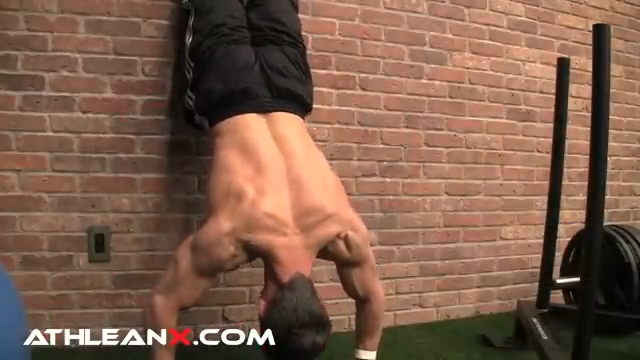
HOW TO DO ISOMETRIC HANDSTAND PUSH UP HOLDS:
- When you’re at the low static position, squeeze your hands together and press into the floor—just like with the Push-Up.
- This increases muscle engagement in your shoulders and activates stabilizing muscles in your back that don’t normally get worked as hard during typical concentric phase or dynamic movements.
- You’ll be working muscle fibers that aren’t just responsible for pressing but for stabilization too—making this hold incredibly valuable for both stability and power.
WHAT MAKES IT EFFECTIVE: If you want to take things to the extreme, try isometric handstand push-up holds. Whether against a wall or freestanding, this isometric action works your shoulders, triceps, and even core muscles. Lower yourself slowly into the bottom portion of the movement and hold there.
MODIFIED L-SIT


HOW TO DO THE MODIFIED L SIT:
- Let’s talk about an isometric workout that will challenge your core like nothing else—a modified L-sit.
- You can do this from parallel bars or even hanging from a Pull-Up bar.
- Lift your legs into a 90-degree “tabletop position” or a straight-out L-sit. Then, hold.
- Even with your knees bent, the knee angle keeps the core muscles fully engaged, targeting not only the abs but also the oblique muscles.
- The key is to maintain the isometric hold for 20-30 seconds, then go back into dynamic knee lifts.
WHAT MAKES IT EFFECTIVE: Adding these holds throughout your fitness routine takes core training to a new level. The time spent in these holds generates PIMA force outputs that help boost muscle activation levels and, ultimately, muscle growth. Holding these positions forces every part of your body to work together, from the calf muscles to the shoulders, to maintain balance and stability.
WALL SITS


HOW TO DO WALL SITS:
- Start with your back against the wall, feet hip-width apart and slide down until your knees are at 90-degree angles.
- Your feet should remain flat on the ground, and your weight should be evenly distributed.
- Hold this isometric contraction for no less than 30 seconds, keeping your core tight and your body in position throughout.
WHAT MAKES IT EFFECTIVE: Wall Sits are a simple but effective isometric exercise prescription that targets the quads, hamstrings, and glutes. By holding the static position, you’re forcing your leg muscles to endure constant tension, leading to increased muscle activation. This exercise is fantastic for aerobic exercise training with lower intensity, making it accessible to all fitness levels. It also helps with bilateral load share, ensuring both legs are equally engaged.
STATIC LUNGE HOLDS

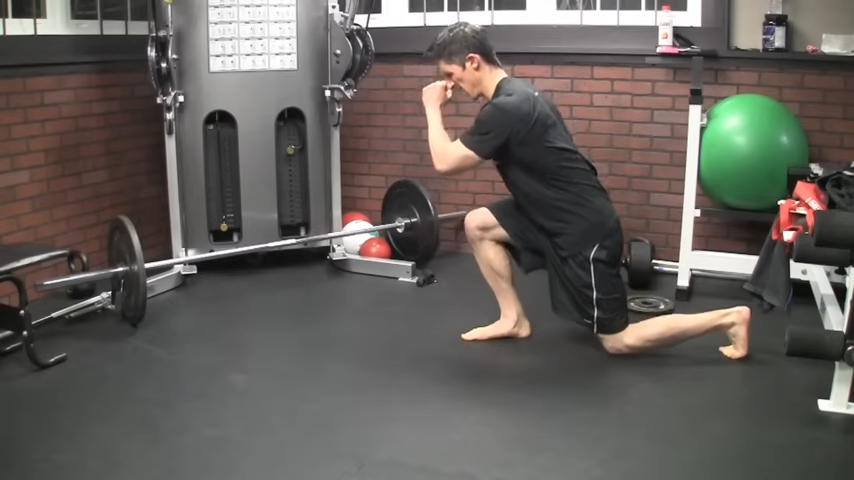
HOW TO DO STATIC LUNGE HOLDS:
- Get into a lunge position, with your front knee bent at a 90-degree angle.
- Your back knee should be just above the ground, and your body position should remain upright with your chest lifted.
- Hold this position, ensuring your front knee does not extend past your toes, and keep your weight evenly distributed between both legs—this helps maintain a stable unilateral load share.
WHAT MAKES IT EFFECTIVE: This type of muscle contraction challenges the stabilizer muscles in both your legs and core. Static Lunge Holds work the glutes, quads, and hamstrings, while also improving balance and coordination. Holding the position forces you to maintain constant muscle activation, which helps build strength in the stabilizers and prime movers alike. The stance phase in this exercise makes it an excellent tool for anyone looking to increase muscle endurance, balance, and strength without the high impact of repeated repetitions.
CALF RAISE HOLDS


HOW TO DO CALF RAISE HOLDS:
- Lift up onto the balls of your feet, ensuring your feet are flat at the top of the movement—meaning your body is stable, not rolling to the sides.
- Hold this elevated position for no less than 30 seconds.
- Make sure your knees are slightly bent and that you’re maintaining balance.
- If needed, lightly hold onto a wall or a bar with hands shoulder-width apart for additional stability.
WHAT MAKES IT EFFECTIVE: Your calf muscles will thank you (or hate you) for this one. During the hold, the blood vessels narrow slightly due to muscle contraction, which helps improve blood flow when you release. This exercise is excellent for improving balance and stability in your lower legs, which plays an important role in overall athletic performance. By holding at the top, you’re maximizing muscle activation at peak contraction and pushing those 60-80% maximal PIMA outputs.
Incorporating isometric exercises into your fitness routine is a proven way to enhance muscle strength, improve joint health, and reduce the risk of injury.
Whether you’re holding a plank to target your core muscles or adding an isometric hold at the end of a biceps curl to increase tension, these exercises will challenge your muscles in new ways.
Plus, they’re incredibly joint-friendly and scalable, making them suitable for athletes of all levels.
So, if you haven’t added isometrics to your workout yet, it’s time to start—and you’ll feel the benefits in no time.
Check out our ATHLEAN-X programs to see which is the best fit for your personal fitness goals and fitness level.

- Often overlooked, isometric exercises can help build muscle mass and strength by engaging muscles in ways dynamic movements can’t. There are two types of isometrics exercises:
- Yielding Isometrics: Holding a position to resist movement (e.g., plank or squat hold), which generates tension crucial for muscle activation and growth.
- Overcoming Isometrics: Pushing or pulling against an immovable object (e.g., isometric curl against a locked barbell), which boosts muscle fiber engagement.
- Isometric holds maintain peak muscle tension throughout, leading to greater muscle fiber recruitment and enhancing muscle growth and strength.
- Holding isometric positions for 30-60 seconds keeps muscles constantly engaged, increasing muscle mass, strength, endurance, and stability with minimal joint movement, while longer holds effectively fatigue muscles and boost activation.
- Incorporate exercises like Planks, Isometric Push-Up Holds, Pull-Up Holds, Isometric Handstand Push-Up Holds, Modified L-Sits, Wall Sits, Static Lunge Holds, and Calf Raise Holds to target different muscle groups, enhance stability, and build strength efficiently.
ISOMETRICS FAQS
An example of an isometric exercise is the Plank. You’re getting into position—elbows under shoulders, core tight, body straight like a board—and holding it.
No movement, just pure isometric muscle contraction. That means you’re not shortening or lengthening the muscle, but instead keeping it under constant tension.
The Plank is a killer way to engage your core without putting your back at risk, and it's one of the simplest yet most effective isometric exercises out there.
It’s the perfect addition to your routine when your goal is to build stability and endurance without adding dynamic movement.
If we dive into an analysis of exercise intervention, the Plank is a classic example of how isometrics help build muscular endurance by holding a static position and forcing your muscles to maintain that tension for an extended period.
This is where your body learns to adapt, build strength, and boost endurance—all without needing any fancy equipment or dynamic reps.
Here are four benefits of isometric training:
Increased Muscle Activation: When you’re holding a muscle contraction without movement, like a plank or wall sit, you're recruiting more muscle fibers to maintain that position. This means more muscles are firing, leading to greater muscle activation and strength gains.
Reduced Joint Stress: Unlike dynamic exercises that involve a lot of joint movement, isometrics keep the joints stable. This reduces wear and tear, making isometric training an excellent choice for anyone recovering from injury or wanting to build strength without risking joint health.
Improved Stability and Endurance: Holding positions for extended periods builds muscular endurance and stabilizes key muscles. This translates into better control over your movements in everyday life and during your regular workouts. Stability is the foundation for better lifts and injury prevention.
Convenience: You don’t need a gym or heavy weights for isometric training. You can get a serious workout just by holding bodyweight positions like a wall sit or L-sit. This makes isometric exercises extremely versatile and easy to incorporate, no matter where you are.
There isn’t one "best" isometric exercise—it depends on your goals. Several isometric exercises offer unique benefits, and incorporating a mix will maximize your gains.
The Plank is a full body move that targets the core, shoulders, and glutes, perfect for building core stability. The Isometric Push-Up Hold engages the chest, shoulders, and triceps, while the Pull-Up Hold challenges your back and biceps, adding strength and control.
For a bigger challenge, Isometric Handstand Push-Up Holds tests your shoulders, triceps, and core, while the Modified L-Sit builds serious core strength. The Wall Sit hits your quads and glutes, building endurance, and the Static Lunge Hold strengthens the quads and glutes. Lastly, Calf Raise Holds focus on calf muscles, improving lower-leg strength and stability.
Each exercise brings something different, so mix them into your routine based on what you want to improve—whether it’s core stability, upper-body strength, or lower-body endurance.
You can do isometrics every day, but it comes down to intensity and recovery.
If you're doing lighter isometric holds like planks or wall sits, you can add them daily without too much risk.
They’re great for building core stability and reinforcing muscle activation patterns without adding a lot of fatigue.
However, if you’re holding high-intensity isometrics with heavy loads—like pushing against an immovable object at maximum effort—your muscles need time to recover, just like with any other form of strength training.
It’s all about finding balance. Use isometrics to complement your training, but listen to your body, and take rest days when needed to ensure full recovery.
Absolutely. Isometrics can build muscle. You see, muscle growth is all about tension—keeping your muscles engaged under load.
Isometric holds create constant mechanical tension, which is a key factor in muscle hypertrophy.
Whether you’re holding a plank or squeezing out a wall sit, those muscles are under maximum load for the entire hold.
Think of it like this: you’re not just hanging out; you’re actively contracting, pushing, or pulling.
The more tension you generate, the greater the potential for muscle growth.
Plus, using isometrics in combination with dynamic exercises can boost overall strength, making them a powerful addition to any muscle-building plan.

Jeff Cavaliere M.S.P.T, CSCS
Jeff Cavaliere is a Physical Therapist, Strength Coach and creator of the ATHLEAN-X Training Programs and ATHLEAN-Rx Supplements. He has a Masters in Physical Therapy (MSPT) and has worked as Head Physical Therapist for the New York Mets, as well as training many elite professional athletes in Major League Baseball, NFL, MMA and professional wrestling. His programs produce “next level” achievements in muscle size, strength and performance for professional athletes and anyone looking to build a muscular athletic physique.






